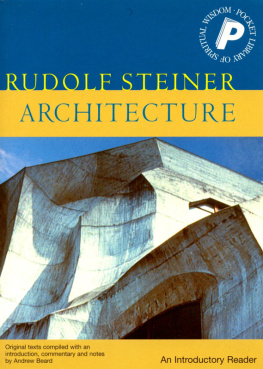Kolarevic Branko - Building Dynamics: Exploring Architecture of Change
Here you can read online Kolarevic Branko - Building Dynamics: Exploring Architecture of Change full text of the book (entire story) in english for free. Download pdf and epub, get meaning, cover and reviews about this ebook. year: 2015, publisher: Routledge, genre: Romance novel. Description of the work, (preface) as well as reviews are available. Best literature library LitArk.com created for fans of good reading and offers a wide selection of genres:
Romance novel
Science fiction
Adventure
Detective
Science
History
Home and family
Prose
Art
Politics
Computer
Non-fiction
Religion
Business
Children
Humor
Choose a favorite category and find really read worthwhile books. Enjoy immersion in the world of imagination, feel the emotions of the characters or learn something new for yourself, make an fascinating discovery.
- Book:Building Dynamics: Exploring Architecture of Change
- Author:
- Publisher:Routledge
- Genre:
- Year:2015
- Rating:4 / 5
- Favourites:Add to favourites
- Your mark:
- 80
- 1
- 2
- 3
- 4
- 5
Building Dynamics: Exploring Architecture of Change: summary, description and annotation
We offer to read an annotation, description, summary or preface (depends on what the author of the book "Building Dynamics: Exploring Architecture of Change" wrote himself). If you haven't found the necessary information about the book — write in the comments, we will try to find it.
Building Dynamics: Exploring Architecture of Change — read online for free the complete book (whole text) full work
Below is the text of the book, divided by pages. System saving the place of the last page read, allows you to conveniently read the book "Building Dynamics: Exploring Architecture of Change" online for free, without having to search again every time where you left off. Put a bookmark, and you can go to the page where you finished reading at any time.
Font size:
Interval:
Bookmark:
Edited By
Branko Kolarevic & Vera Parlac

First published 2015
by Routledge
2 Park Square, Milton Park, Abingdon, Oxon OX14 4RN
and by Routledge
711 Third Avenue, New York, NY 10017
Routledge is an imprint of the Taylor & Francis Group, an informa business
2015 Branko Kolarevic & Vera Parlac, selection and editorial matter; individual chapters, the contributors
The right of the editors to be identified as the authors of the editorial material, and of the authors for their individual chapters, has been asserted in accordance with sections 77 and 78 of the Copyright, Designs and Patents Act 1988.
All rights reserved. No part of this book may be reprinted or reproduced or utilised in any form or by any electronic, mechanical, or other means, now known or hereafter invented, including photocopying and recording, or in any information storage or retrieval system, without permission in writing from the publishers.
Trademark notice: Product or corporate names may be trademarks or registered trademarks, and are used only for identification and explanation without intent to infringe.
Publisher's Note
This book has been prepared from camera-ready copy provided by the editors.
British Library Cataloguing-in-Publication Data
A catalogue record for this book is available from the British Library
Library of Congress Cataloging-in-Publication Data
Kolarevic, Branko, 1963
Building dynamics: exploring architecture of change / Branko Kolarevic and Vera Parlac.
pages cm
Includes bibliographical references and index.
1. Intelligent buildings. 2. Smart structures. 3. Structural dynamics. I. Parlac, Vera. II. Title.
TH6012.K65 2016
690'.21dc23
2015008601
ISBN: 978-1-138-79101-5 (hbk)
ISBN: 978-1-138-79102-2 (pbk)
ISBN: 978-1-315-76327-9 (ebk)
Designed and typeset in Bell Gothic by Branko Kolarevic and Vera Parlac
| (Kolarevic) |
| (Leatherbarrow) |
| (Kronenburg) |
| (Sinclair) |
| (Addington) |
| (Kolarevic & Parlac) |
| (Hathaway) |
| (Hoberman) |
| (Sterk) |
| (Tibbits) |
| (Fox) |
| (Parlac) |
| (Parlac) |
| (Beesley) |
| (el-Khoury & Moukheiber) |
| (Haque) |
| (Oosterhuis & Lnrd) |
| (Ruiz-Geli) |
We thank with the deepest gratitude the contributors to this book their remarkable ideas and innovative, pioneering projects were the main inspiration for this book and the eponymous symposium that preceded it. In April of 2013, we gathered in Banff, in the Canadian Rocky Mountains, to explore over two days what change means in architecture and how it is manifested in buildings today. The symposium presentations, enriched by the ensuing discussions and email exchanges, have been further refined and captured in this book. Not all of the authors were able to join us at the symposium, but have kindly agreed to contribute to the book.
The Building Dynamics: Exploring Architecture of Change symposium and the accompanying exhibition of student work and research projects were organized by the Laboratory for Integrative Design (LID) at the University of Calgary Faculty of Environmental Design (EVDS) and held at the Banff Centre on April 26 and 27, 2013. We are most grateful to the symposium sponsors: Oldcastle BuildingEnvelope, DIRTT, Haworth, and Faculty of Environmental Design at the University of Calgary; without their support, the symposium and this book would not have been possible. Initial formative research was supported by the grants from the University Research Grants Council (URGC) and by funding through the Chair for Integrated Design and Laboratory for Integrative Design (LID) at the University of Calgary.
We are profoundly appreciative of the University of Calgary, one of Canadas top research universities. We are particularly grateful to Nancy Pollock-Ellwand, Dean of the Faculty of Environmental Design, for the encouragement and support for our work. We also want to thank the Banff Centre for embracing this project from its outset and for providing us with access to their world-class facilities in the midst of the magnificent Rocky Mountains.
Finally, and most importantly, we want to thank our students and our colleagues for the stimulating conversations about the subject of this book, which was explored in advanced design studios and elective courses offered through the Faculty of Environmental Design (EVDS). In particular, we want to acknowledge students who were involved with the ideas, content, and organization of the symposium and its accompanying exhibition: Nicholas Dykstra, Lauren Dynes, Salman Khalili, Mackenzie Nixon, Neal Philipsen, and Sadaf Rabani.
We are grateful to Francesca Ford at Taylor and Francis for her enthusiastic support of this project and Trudy Varcianna and Edward Gibbons for patiently navigating the editing of the manuscript and production of the book. Special thanks are due to Susan Dunsmore for her painstaking copyediting of the manuscript.
At a personal level, we want to thank our son, Marko Parlac Kolarevic, for putting up with his parents as we spent many afternoons and evenings working on this project. The book is dedicated to him.
Branko Kolarevic and Vera Parlac
Calgary, February 2015
The book stems from our interest in architecture that can respond dynamically to changes in external and internal environments and different patterns of use. Buildings are increasingly being equipped with sensors, actuators, and controllers, enabling them to collect information from both outside and inside and then process that information and act on it autonomously or interactively by reconfiguring themselves, changing some of the environmental conditions, or adapting, i.e., responding in some other way. As a consequence, two-way relationships could be established among the spaces, environment, and users: users or changes in the environment could affect the configuration of spaces and vice versa. The result is an architecture that self-adjusts, that continuously changes an architecture that is adaptive, interactive, reflexive, responsive ...
In a way, buildings are becoming large-scale robots, transformers that are (still) fixed to a particular location but could alter their shape or appearance. This book, however, is not just about such technologically-enabled transformations of buildings. It goes beyond the current fascination with mechatronics, i.e. creative combinations of electronics and mechanical systems that process signals collected from the environment through sensors and then generate output signals, turning them through actuating components into forces, motions, and other actions that result in some qualitatively beneficial change.
Our aim with this book is to explore what change means in architecture and how it is manifested: buildings weather, programs change, envelopes adapt, interiors are reconfigured, systems replaced. We are interested in the kinds of changes that buildings could and should undergo and the scale and speed at which they would occur. We want to examine which changes are necessary, useful, desirable, possible
The principal motivation behind the book is that change in architecture is far from being adequately addressed or explored theoretically, experimentally, or phenomenologically. But that was not the only driver of our interest in what, why, when, and how things change in buildings. Time is implicated in any notion of change in architecture; as a design dimension, time is often neglected and is insufficiently explored either in design studio projects in schools or in real-world projects in firms. We need to make space for time as David Leatherbarrow argues in his chapter in this book.
Font size:
Interval:
Bookmark:
Similar books «Building Dynamics: Exploring Architecture of Change»
Look at similar books to Building Dynamics: Exploring Architecture of Change. We have selected literature similar in name and meaning in the hope of providing readers with more options to find new, interesting, not yet read works.
Discussion, reviews of the book Building Dynamics: Exploring Architecture of Change and just readers' own opinions. Leave your comments, write what you think about the work, its meaning or the main characters. Specify what exactly you liked and what you didn't like, and why you think so.







![Architecture for Humanity - Design like you give a damn [2] building change from the ground up](/uploads/posts/book/178090/thumbs/architecture-for-humanity-design-like-you-give-a.jpg)


